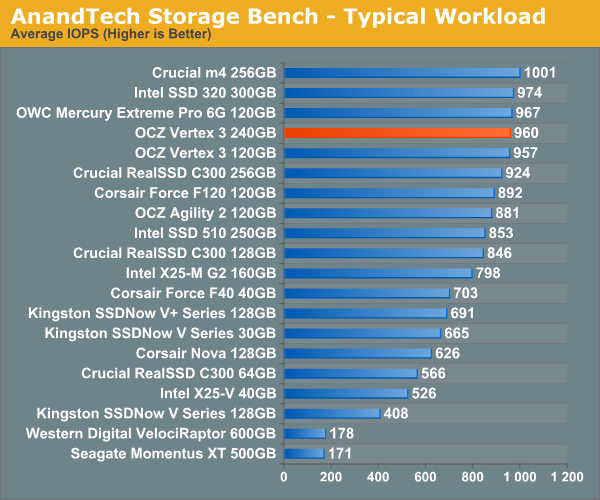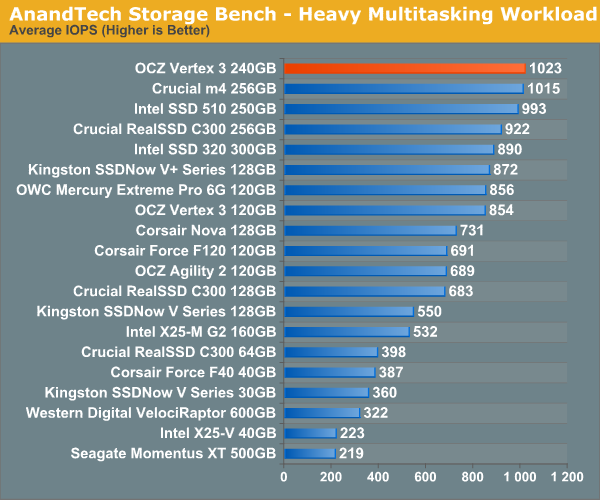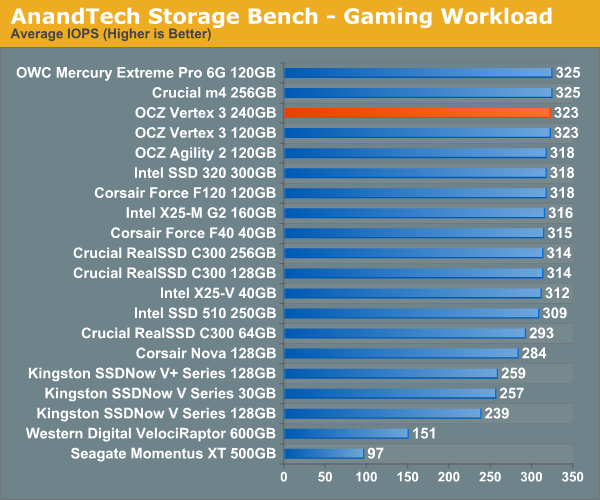OCZ Vertex 3 (240GB) Review
by Anand Lal Shimpi on May 6, 2011 1:50 AM ESTAnandTech Storage Bench 2010
To keep things consistent we've also included our older Storage Bench. Note that the old storage test system doesn't have a SATA 6Gbps controller, so we only have one result for the 6Gbps drives.
The first in our benchmark suite is a light/typical usage case. The Windows 7 system is loaded with Firefox, Office 2007 and Adobe Reader among other applications. With Firefox we browse web pages like Facebook, AnandTech, Digg and other sites. Outlook is also running and we use it to check emails, create and send a message with a PDF attachment. Adobe Reader is used to view some PDFs. Excel 2007 is used to create a spreadsheet, graphs and save the document. The same goes for Word 2007. We open and step through a presentation in PowerPoint 2007 received as an email attachment before saving it to the desktop. Finally we watch a bit of a Firefly episode in Windows Media Player 11.
There’s some level of multitasking going on here but it’s not unreasonable by any means. Generally the application tasks proceed linearly, with the exception of things like web browsing which may happen in between one of the other tasks.
The recording is played back on all of our drives here today. Remember that we’re isolating disk performance, all we’re doing is playing back every single disk access that happened in that ~5 minute period of usage. The light workload is composed of 37,501 reads and 20,268 writes. Over 30% of the IOs are 4KB, 11% are 16KB, 22% are 32KB and approximately 13% are 64KB in size. Less than 30% of the operations are absolutely sequential in nature. Average queue depth is 6.09 IOs.
The performance results are reported in average I/O Operations per Second (IOPS):

If there’s a light usage case there’s bound to be a heavy one. In this test we have Microsoft Security Essentials running in the background with real time virus scanning enabled. We also perform a quick scan in the middle of the test. Firefox, Outlook, Excel, Word and Powerpoint are all used the same as they were in the light test. We add Photoshop CS4 to the mix, opening a bunch of 12MP images, editing them, then saving them as highly compressed JPGs for web publishing. Windows 7’s picture viewer is used to view a bunch of pictures on the hard drive. We use 7-zip to create and extract .7z archives. Downloading is also prominently featured in our heavy test; we download large files from the Internet during portions of the benchmark, as well as use uTorrent to grab a couple of torrents. Some of the applications in use are installed during the benchmark, Windows updates are also installed. Towards the end of the test we launch World of Warcraft, play for a few minutes, then delete the folder. This test also takes into account all of the disk accesses that happen while the OS is booting.
The benchmark is 22 minutes long and it consists of 128,895 read operations and 72,411 write operations. Roughly 44% of all IOs were sequential. Approximately 30% of all accesses were 4KB in size, 12% were 16KB in size, 14% were 32KB and 20% were 64KB. Average queue depth was 3.59.

The gaming workload is made up of 75,206 read operations and only 4,592 write operations. Only 20% of the accesses are 4KB in size, nearly 40% are 64KB and 20% are 32KB. A whopping 69% of the IOs are sequential, meaning this is predominantly a sequential read benchmark. The average queue depth is 7.76 IOs.











90 Comments
View All Comments
tech6 - Friday, May 6, 2011 - link
Thanks for another thorough review. I noticed that the Samsung 470 (and its OEM equivalent) are getting very popular. Any chance of a review?Anand Lal Shimpi - Friday, May 6, 2011 - link
I've been meaning to do a roundup focusing on 3Gbps drives and diving deeper on the 470, it's just a matter of finding the time. It's definitely on the list though.Take care,
Anand
darwinosx - Friday, May 6, 2011 - link
With Samsungs drive division having been sold to Seagate you have to wonder what happens to service and support of Samsung branded drives.TotalLamer - Friday, May 6, 2011 - link
...any chance the Vertex 3s won't spontaneously brick themselves whenever they damned well choose like the Vertex 2s did? Such horridly unreliable drives.No Intel, no care.
jmunjr - Friday, May 6, 2011 - link
A lot of ultraportable laptops use 7mm height drives. From what I ahve read the Vertex series are 9.5mm and cannot be easily modded to fit. The Crucial however have a space that can be easily removed(though it voids the warranty). Is really would be nice to have more SSD choices in the 7mm height option.jcompagner - Friday, May 6, 2011 - link
I think also a warning must be given, because they really don't work quite right out of the box with everything default.I have a Dell XPS17 (L702x) and the Vertex 3 240GB, and installing windows 7 (sp1) is quite hard. The default AHCI driver of windows really doesn't work with the Vertex 3. So yes you can install it in sata mode that kind of works but you want AHCI, And setting that after install is not that easy (you really have to make sure that the latest intel drivers are there and then tweak some registry setting)
Best thing to go around this is to use the Intel F6 driver right from the installer of Win7. That will help and then you can install it at once.
The thing is that OCZ sees this as a problem with drivers or the system, i completely don't agree with this, there are many complaining constantly on the forum because of this. And the intel drive that i also have never have these problems they install just fine. So it is really OCZ which should look into why they are not compatible.
Besides that after you have taken this hurdle you have ofcourse the LPM registry tweak you have to do to kill LPM mode. But this is not only a OCZ/Vertex problem also Crucial (C300) has this same problem. But again with the Intel SSD i haven't seen this problem also.
I just think that the Vertex doesn't behave completely correct on all the SATA commands that are out there. I really hope for them that they can fix that (they get a bit of bad name i know enough forums that really don't recommend OCZ because of all this)
But after all these install troubles i must say it is fast and works quite well.
I don't really like that now a MAXIOPS version is coming also for the 240GB! I am curious of how much faster that will be
One question: If the number of die's tells everything about the speeds, why is the 480GB then slower? (at least on paper)
Ammaross - Friday, May 6, 2011 - link
"One question: If the number of die's tells everything about the speeds, why is the 480GB then slower? (at least on paper) "You didn't read the interleaving example then. If 2 die per chip, and 2 chips per channel fill up 4 of the 5 theoretical "slots" in the 5-clock example, imagine what 4 dies per chip and 2 chips per channel does trying to cram/schedule 8 dies into 5 slots? Then think what happens if all requests are going to one or two die on the same package? It's just a matter of clogging the pipes or burning slots due to a package already processing a request. You can think of it like the 8x/8x/4x SLI/CF situation with P67 where that 3rd gfx card just doesn't help much at all due to being data-starved, or the overhead of SLI/CF in itself.
jcompagner - Saturday, May 7, 2011 - link
but still, why is it even slower and not the same speed as the 240GB then?darwinosx - Friday, May 6, 2011 - link
It seems from public comments on New Egg and elsewhere that there a lot of unhappy owners of tis drive. High failure rate and many people continue to comment on how poor OCZ's tech support is which is the opposite of what this review says.Lingyis - Friday, May 6, 2011 - link
is there something anandtech can test about reliability? i had 3 OCZ vertex from a few years ago and 2 of them had bad sectors after about 6 months of use. whatever time i saved on the SSD was more than wiped out by my time having to reinstall software, and possibly each time it has to run chkdsk related commands. i have been quite reluctant to use SSD since--i went with good ol' HDD in my new laptop and chkdsk has yet to reveal any errors.some time ago, i read on this site that the officially from intel, failure rates are something like 1.2% for non-Intel drives and 0.5% for intel drives? obviously, massive data is required to get these kind of statistics, but if you can figure out some way of testing reliability on these SSD, that'll be much more important to people like me as SSD is fast enough for most practical purposes. perhaps you can run these drives intensely over a period of 30 days (probably more) and see if any data corruption sets in. if there's a way to limit read/write to a certain region of the SSD than better obviously, but the controller i suppose might have a say in that.